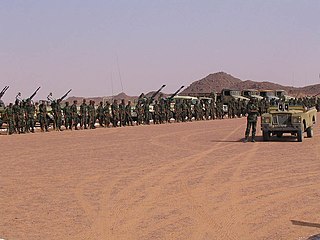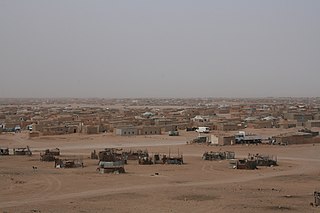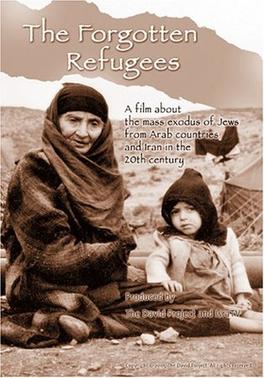
North Africa is a region encompassing the northern portion of the African continent. There is no singularly accepted scope for the region, and it is sometimes defined as stretching from the Atlantic shores of the Western Sahara in the west, to Egypt and Sudan's Red Sea coast in the east.

Western Sahara is a disputed territory on the northwest coast of Africa. About 20% of the territory is controlled by the Sahrawi Arab Democratic Republic (SADR); the remaining 80% of the territory is occupied and administered by neighboring Morocco. It has a surface area of 266,000 square kilometres (103,000 sq mi). It is the second most sparsely populated country in the world and the most sparsely populated in Africa, mainly consisting of desert flatlands. The population is estimated at just over 500,000, of which nearly 40% live in Morocco-controlled Laayoune, the largest city in Western Sahara.
In the 20th century, approximately 900000 Jews migrated, fled, or were expelled from Muslim-majority countries throughout Africa and Asia. Primarily a consequence of the 1948 Arab–Israeli War, the mass movement mainly transpired from 1948 to the early 1970s, with one final exodus of Iranian Jews occurring shortly after the Islamic Revolution in 1979–1980. An estimated 650000 (72%) of these Jews resettled in Israel.
This article lists expulsions, refugee crises and other forms of displacement that have affected Jews.

Maghrebi Jews or North African Jews are ethnic Jews who had traditionally lived in the Maghreb region of North Africa under Arab rule during the Middle Ages. Established Jewish communities had existed in North Africa long before the arrival of Sephardi Jews, expelled from Portugal and Spain. Due to proximity, the term 'Maghrebi Jews' sometimes refers to Egyptian Jews as well, even though there are important cultural differences between the history of Egyptian and Maghrebi Jews. These Jews originating from North Africa constitute the second largest Jewish diaspora group.
Mizrahi Jews, also known as Mizrahim (מִזְרָחִים) or Mizrachi (מִזְרָחִי) and alternatively referred to as Oriental Jews or Edot HaMizrach, are a grouping of Jewish communities comprising those who remained in the Land of Israel and those who existed in diaspora throughout and around the Middle East and North Africa (MENA) from biblical times into the modern era.
The Independence Intifada or the Second Sahrawi Intifada and also May Intifada is a Sahrawi activist term for a series of disturbances, demonstrations and riots that broke out in May 2005 in the Moroccan-controlled parts of Western Sahara and south of Morocco. This event has also been called The El-Aaiun Intifada by the same sources.

The Government of Morocco sees Western Sahara as its Southern Provinces. The Moroccan government considers the Polisario Front as a separatist movement given the alleged Moroccan origins of some of its leaders.

The Western Sahara conflict is an ongoing conflict between the Sahrawi Arab Democratic Republic/Polisario Front and the Kingdom of Morocco. The conflict originated from an insurgency by the Polisario Front against Spanish colonial forces from 1973 to 1975 and the subsequent Western Sahara War against Morocco between 1975 and 1991. Today the conflict is dominated by unarmed civil campaigns of the Polisario Front and their self-proclaimed SADR state to gain fully recognized independence for Western Sahara.
Jews Indigenous to the Middle East and North Africa (JIMENA) is a non-profit organization headquartered in San Francisco, California that is dedicated to the preservation of Mizrahi and Sephardi culture and history, and seeks to educate the public and advocate for Jewish refugees from the Middle East.

The Sahrawi refugee camps, also known as the Tindouf camps, are a collection of refugee camps set up in the Tindouf Province, Algeria in 1975–76 for Sahrawi refugees fleeing from Moroccan forces, who advanced through Western Sahara during the Western Sahara War. With most of the original refugees still living in the camps, the situation is among the most protracted in the world.

Sahrawi nationality law is the law of the Sahrawi Arab Democratic Republic's (SADR) governing nationality and citizenship. The SADR is a partially recognized state which claims sovereignty over the entire territory of Western Sahara, but only administers part of it. The SADR also administers Sahrawi refugee camps.

The Forgotten Refugees is a 2005 documentary film directed by Michael Grynszpan and produced by The David Project and IsraTV with Ralph Avi Goldwasser as executive producer, that recounts the history of Jewish communities of the Middle East and North Africa and their demise in the face of persecutions following the creation of the modern State of Israel in 1948.

In 1948, more than 700000 Palestinian Arabs – about half of prewar Mandatory Palestine's Arab population – fled from their homes or were expelled by Zionist militias and, later, the Israeli army during the 1948 Palestine war, following the Partition Plan for Palestine. The expulsion and flight was a central component of the fracturing, dispossession, and displacement of Palestinian society, known as the Nakba. Dozens of massacres were conducted by Israeli military forces and between 400 and 600 Palestinian villages were destroyed. Village wells were poisoned in a biological warfare programme and properties were looted to prevent Palestinian refugees from returning. Other sites were subject to Hebraization of Palestinian place names. These activities were not necessarily limited to the year 1948.

The Gdeim Izik protest camp was a protest camp in Western Sahara, established on 9 October 2010 and lasting into November that year, with related incidents occurring in the aftermath of its dismantlement on 8 November. The primary focus of the protests was against "ongoing discrimination, poverty and human rights abuses against local citizens".
Sahrawi refugees refers to the refugees of the Western Sahara War (1975–1991) and their descendants, who are still mostly populating the Sahrawi refugee camps in Tindouf, Algeria.
The 1956–57 exodus and expulsions from Egypt was the exodus and expulsion of Egypt's Mutamassirun, which began during the latter stages of the Suez Crisis in Nasserist Egypt.
A refugee crisis can refer to difficulties and dangerous situations in the reception of large groups of forcibly displaced persons. These could be either internally displaced, refugees, asylum seekers or any other huge groups of migrants.

The Second Arab Spring is a series of anti-government protests which took place in Algeria, Egypt, Iraq, Jordan, Lebanon, Libya, Morocco, Oman, Sudan, Syria and Tunisia, with several starting in late 2018. Economic protests also took place in the Gaza Strip.
Title 42 expulsions were removals by the U.S. government of people who had recently been in a country where a communicable disease was present. The extent of authority for contagion-related expulsions is set out by law in 42 U.S.C. § 265. During the COVID-19 pandemic, the Trump administration used this provision to generally block land entry for many migrants. This practice was initially continued by the Biden administration before the program was ended with the end of the COVID-19 national emergency in the United States. Title 42 of the United States Code includes numerous sections dealing with public health, social welfare, and civil rights, but, in the context of immigration, the phrase "Title 42" came to be used to refer specifically to expulsions under section 265.












